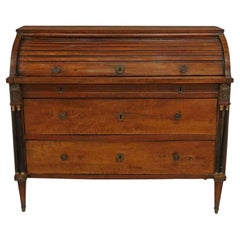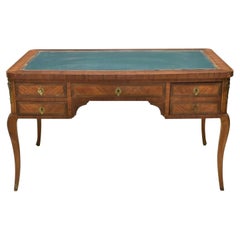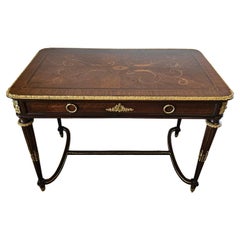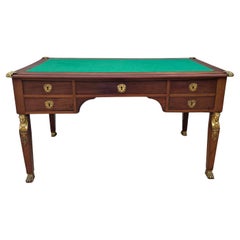Want more images or videos?
Request additional images or videos from the seller
1 of 21
Early 19th Century Louis XVI Style Gentleman's Bureau Dressing Table Vanity Desk
Price:$10,957
$17,950List Price
About the Item
- Similar to:Jean-Henri Riesener (Cabinetmaker)
- Dimensions:Height: 31.5 in (80.01 cm)Width: 54.75 in (139.07 cm)Depth: 27.5 in (69.85 cm)
- Style:Louis XVI (In the Style Of)
- Materials and Techniques:
- Place of Origin:
- Period:
- Date of Manufacture:circa 1800
- Condition:Replacements made: Original mirror hinge (likely ratcheting) has been replaced with a static hinge. Wear consistent with age and use. Great antique condition with nicely aged warm patina. Strong, sturdy, stable, presents very well. Mirror hinge replaced. Wear consistent with age & use. Delivered cleaned, waxed, hand polished, ready for immediate use & generational enjoyment.
- Seller Location:Forney, TX
- Reference Number:1stDibs: LU5977240704902
About the Seller
4.8
Platinum Seller
Premium sellers with a 4.7+ rating and 24-hour response times
Established in 2013
1stDibs seller since 2021
302 sales on 1stDibs
Authenticity Guarantee
In the unlikely event there’s an issue with an item’s authenticity, contact us within 1 year for a full refund. DetailsMoney-Back Guarantee
If your item is not as described, is damaged in transit, or does not arrive, contact us within 7 days for a full refund. Details24-Hour Cancellation
You have a 24-hour grace period in which to reconsider your purchase, with no questions asked.Vetted Professional Sellers
Our world-class sellers must adhere to strict standards for service and quality, maintaining the integrity of our listings.Price-Match Guarantee
If you find that a seller listed the same item for a lower price elsewhere, we’ll match it.Trusted Global Delivery
Our best-in-class carrier network provides specialized shipping options worldwide, including custom delivery.You May Also Like
Louis XVI style Bureau plat, 19th Century
Located in Brighton, Sussex
A very good quality late 19th Century French Louis XVI style bureau plat. Having an inset leather top, gilded ormolu mouldings and mounts. Trellis parquetry to the frieze, with flora...
Category
Antique Late 19th Century French Louis XVI Desks and Writing Tables
Materials
Mahogany
19th Century Italian Louis XVI Style Desk
Located in Houston, TX
19th Century Italian Louis XVI Style Desk.
Offered is a lovely late 19th century Italian painted and giltwood bureau plat or desk with a single drawer and a beautiful marble top.
Thi...
Category
Antique 19th Century Italian Louis XVI Desks and Writing Tables
Materials
Marble
Fine Quality Louis XVI Style Bureau Plat, 19th Century
Located in Brighton, Sussex
A very good quality 19th century Louis XVI style mahogany bureau plat. Having an inset leather top, wonderful gilded ormolu mounts, the single frieze drawer having a drop front, open...
Category
Antique 19th Century French Louis XVI Desks and Writing Tables
Materials
Ormolu
$30,557 Sale Price
20% Off
H 31.89 in W 51.58 in D 29.53 in
19th Century Louis XVI Bureau à Cylindre or Roll Top Desk
Located in Winter Park, FL
A fine early 19th century Louis XVI period bureau à cylindre, or roll top desk, made of solid walnut with marquetry veneers of walnut, mahogany and cherry. Pine as a secondary wood. ...
Category
Antique Early 19th Century French Louis XVI Desks and Writing Tables
Materials
Brass
19th Century Louis XVI Style Leather Top Writing Table / Bureau Plat
Located in Madrid, ES
A 19th century Louis XVI style French writing table or desk, known as a "bureau plat”. It has a leather top writing surface, ormolu bronze details, and three locking drawers with fal...
Category
Antique 19th Century French Louis XVI Desks and Writing Tables
Materials
Ormolu
$7,695
H 31.5 in W 57.09 in D 31.5 in
French 19th Century Louis XVI style bureau plat.
Located in Brighton, Sussex
A very good quality late 19th Century French parquetry inlaid Louis XVI style bureau plat. Having an inset leather tooled top, gilded ormolu mouldings and classical monopodia mounts ...
Category
Antique Late 19th Century French Louis XIV Desks and Writing Tables
Materials
Ormolu
$8,185 Sale Price
20% Off
H 30.32 in W 64.57 in D 35.44 in
19th Century French Louis XVI Style Ebonized Desk
Located in Houston, TX
19th Century French Louis XVI Style Ebonized Desk.
Outstanding 19th century French Louis XVI style desk, writing table, bureau plat or center table with a single drawer, solid bronze...
Category
Antique 19th Century French Louis XVI Desks and Writing Tables
Materials
Bronze
French 19th Century Louis XVI Style Mahogany Desk
Located in West Palm Beach, FL
A handsome and most elegant French 19th century Louis XVI st. Mahogany, Tulipwood, Charmwood, and ormolu desk. The five drawer desk is raised by slender square tapered legs with fine...
Category
Antique 19th Century French Louis XVI Desks and Writing Tables
Materials
Ormolu
French 19th Century Gentleman’s Dressing Table
Located in Baton Rouge, LA
A distinct and stately Neoclassical gentleman’s dressing table from France, perhaps inspired by the influential English aesthete Beau Brummell whose high standards for personal appea...
Category
Antique 19th Century French Neoclassical Vanities
Materials
Marble, Brass
Frederic Schmit, Paris, Large Louis XVI Style Bureau Plat, 19th Century
By Frédéric Schmit
Located in Brighton, Sussex
A fine quality 19th century marquetry inlaid French Louis XVI style bureau plat. Having an inset tooled leather top, an ormolu moulding around, three oak lined frieze drawers, with the locks stamped; Schmit, Paris. Dummy drawers to the reverse.
The frieze being bombe shaped all the way round, quartered veneers and marquetry inlay. Wonderful ormolu monopodia supports to the tops of the elegant cabriole legs that terminate in hairy paw feet.
Frédéric Schmit...
Category
Antique 19th Century French Louis XVI Desks and Writing Tables
Materials
Kingwood, Mahogany
$41,471 Sale Price
20% Off
H 31.5 in W 60.24 in D 33.47 in
More From This Seller
View AllEarly 19th Century French Empire Period Bureau a Cylindre Gentleman's Desk
Located in Forney, TX
A exceptionally rare Period French Empire (1804-1814) walnut bureau a cylindre.
Exquisitely hand-crafted in France, most likely Parisian work, dating to the early 19th century, the large antique cylinder desk...
Category
Antique Early 19th Century French Empire Desks and Writing Tables
Materials
Bronze
Early 20th Century French Louis XVI Mahogany Leather Top Bureau Plat
Located in Forney, TX
An antique Louis XVI style writing desk with beautiful patina. Hand crafted in France in the early 20th century, featuring a rich mahogany finish adorned with gilt bronze ormolu moun...
Category
Early 20th Century French Louis XVI Desks and Writing Tables
Materials
Bronze, Ormolu
Maison Forest Signed French Louis XVI Style Writing Table - Late 19th Century
By Maison Forest
Located in Forney, TX
A rare and very fine quality 19th century French bureau plat by renowned Parisian ébéniste Maison Forest.
Maison Forest is one of the most famous french cabinetmakers of the 19th a...
Category
Antique Late 19th Century French Louis XVI Desks and Writing Tables
Materials
Bronze, Ormolu
19th Century French Empire Style Bronze Mounted Bureau Plat Writing Desk
Located in Forney, TX
A handsome antique French gilt bronze mounted mixed wood bureau plat writing desk with warm dark patina. circa 1880
France, late 19th century, high quality
hand crafted workmanship...
Category
Antique Late 19th Century French Empire Desks and Writing Tables
Materials
Metal, Brass, Bronze, Ormolu
Antique French Louis XVI Bronze Mounted Writing Table
By Claude Michel Clodion, François Linke, Jean-Henri Riesener
Located in Forney, TX
A striking French antique Louis XVI style gilt bronze mounted writing table made after the model by cabinetmaker to King Louis XVI and Marie Antoinetteean, important ébéniste Jean-Henri Riesener (German/French, 1734-1806) and later reproduced by Francois Linke (French, 1855-1946). Signed bronze mounts, Marco.
Born in France in the early 19th century, possibly during the late 18th century Louis XVI period, most likely Parisian work, exquisitely hand-crafted in several woods of contrasting colors including walnut and mahogany to create fine wooden inlays and parquetry detailing. The original partially inset marble top with dramatic veining sits above a flat sided break-fronted front and back adorned with fine bas-relief bronze plaques cast adorned with putti cherubs in the manner of the French sculptor Clodion (Claude Michel, 1738-1814).
The centered front bronze panel disguises a single frieze drawer with dovetail joinery and original key, flanked by gilded bronze foliate mounted rounded corners, a simulated panel drawer to the reverse, embellished on all four sides by intricate finely chiseled, chased and sculpted scrolling laurel ribbon and garland swag ormolu mounts, patinated brass running ornamentation, rising elegantly on four bronze dore ring mounted straight tapering fluted legs, terminating in patinated bronze toupie feet sabots. Signed / marks; the bronzes are stamped / incised Marco.
PROVENANCE / ACQUISITION:
Property from the Collection of Gloria Monnet Nicholson, Tulsa, Oklahoma.
Acquired from highly reputable auction house Heritage Auctions, Dallas, Texas. Fine Furniture & Decorative Arts Signature Auction, catalog #8085.
Dimensions: (approx)
30" High, 32" Wide 21.5" Deep
As warm and attractive as it is useful, having the ideal size and proportions for a variety of different uses, including as a side table, petite bureau...
Category
Antique Early 19th Century French Louis XVI Desks and Writing Tables
Materials
Marble, Brass, Bronze
Early 19th Century American Sheraton Mahogany Campaign Officers Desk
Located in Forney, TX
A rare and most unusual Federal period mahogany campaign field desk from the early 19th century. Believed to have been used as a maritime sea capta...
Category
Antique Early 19th Century American Federal Desks and Writing Tables
Materials
Cherry, Mahogany, Poplar
Recently Viewed
View AllMore Ways To Browse
French Dressing Mirror
Cross Beads
Dressing Table With Marble Top
Brass Inlay Rosewood
Marquetry Bureau
Vanities And Dressing Tables
Marble Cross
Antique Louis Dressing Table
Louis Style Vanity
Cross Inlay Table
Antique Marble Top Vanity With Mirror
French 18th Century Dressing Table
Rosewood Bureaus
Arts And Crafts Dressing Table
French Vanity Desk
Rosewood Marble Antique Marble Top Table
Marquetry Dressing Table
Antique Rosewood Bureau



